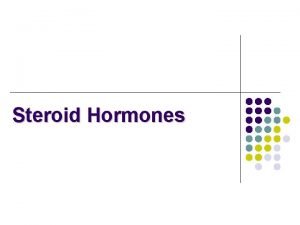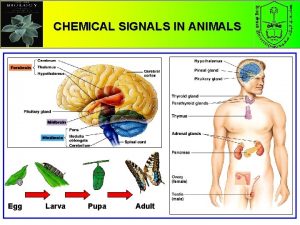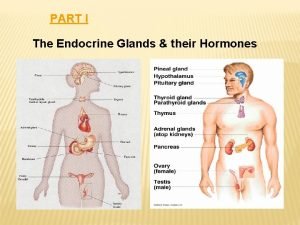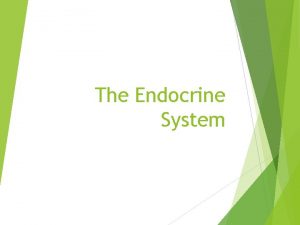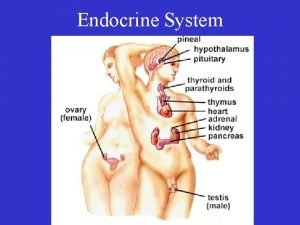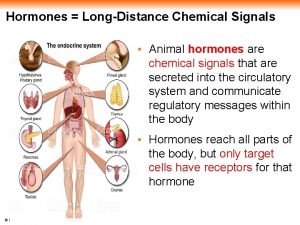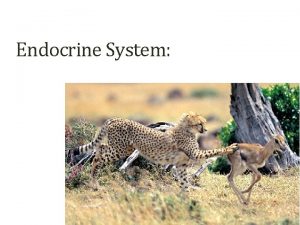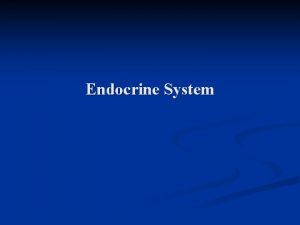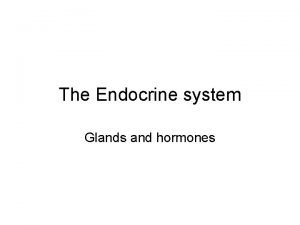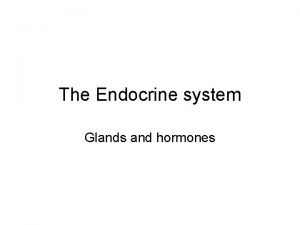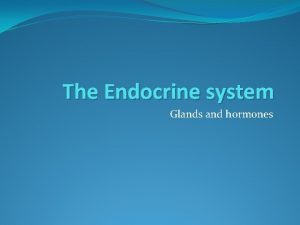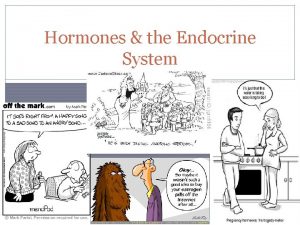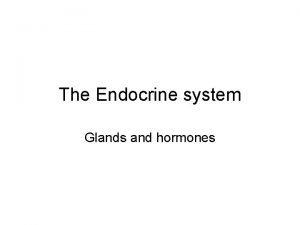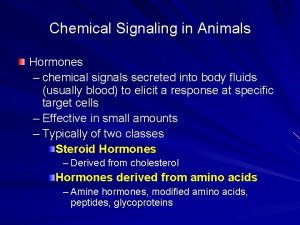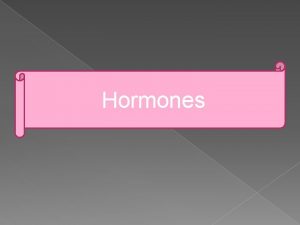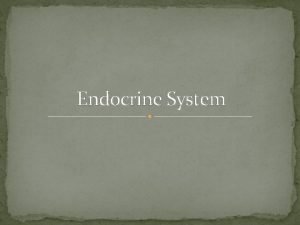Hormones Chemical Signals in Animals Endocrine system Composed















- Slides: 15

Hormones

Chemical Signals in Animals • Endocrine system – Composed of hormone secreting cells and/or glands • Related to and interconnected to the nervous system – Nervous system – high speed short lived effects – Endocrine system – slow longer lasting effects

Protein Activation and Inhibition • Direct protein modification – Example – peptide hormones – Hormone binds to receptor protein on cell surface – Activates signal transduction cascade • Transcriptional control – Example – steroid hormones – Hormone enters the cell and binds to transcription factor – Transcription factor/hormone combination binds to DNA affecting transcription of specific genes.

Same Signal – Different Effect • Signals used in different context have different effects on target cells • Effect depends on proteins receiving the signal

Hormones • Four main types – Peptide hormones – Steroid hormones – Thyroid hormones – Catecholamine hormones

Peptide Hormones • Example – insulin and glucagon – Produced by Langerhans cells in pancreas – Small protein • Antagonistic pair – Insulin (beta cells) – lowers glucose level – Glucagon (alpha cells) – raises glucose level

Glucose Homeostasis • Glucose – insulin released – Most cells have insulin receptors • Cells take up glucose from blood • Slows glycogen breakdown in liver • Stops sugar production from amino acids and fatty acids • 90 mg/100 ml • Glucose – glucagon releases – Liver cells have glucagon receptors • Glycogen converted to glucose • Fats and amino acids converted to sugar

Glucose Homeostasis

Steroid Hormones • Example – corticosteroids – Produced by the adrenal cortex – Small lipophilic molecule – Can pass through the plasma membrane – Control at the transcriptional level

Catecholamine Hormones • Example – epinephrine and norepinephrine – Synthesized in the adrenal medulla – Derived from the amino acid tyrosine

Stress Response • Short term response – Increase glucose (break down glycogen) – Increase heart and breathing rate – Increase blood pressure – Increase metabolic rate – Divert blood flow to brain and skeletal muscles • Long term response – Increase blood volume and pressure – Breakdown of protein and fat into sugar

Stress Response Hormones • Adrenal medulla (short terms stress response) – Directly stimulated by nerve cells from hypothalamus – Produces epinephrine and norepinephrine • Adrenal cortex (long term stress response) – Hypothalamus releasing factor pituitary – Pituitary ACTH adrenal cortex – Produces corticosteroids

Adrenal Gland Stress

Thyroid Hormones • Control metabolism and development • Two hormones derived from tyrosine – Triiodothyronine (T 3) – Thyroxine (T 4) • Controlled by negative feedback loops – Hypothalamus • TRH (TSH-releasing hormone) – Anterior pituitary • TSH (thyroid stimulating hormone)

Thyroid Negative Feedback
 Calcitonin and pth are antagonistic hormones
Calcitonin and pth are antagonistic hormones Chapter 45 hormones and the endocrine system
Chapter 45 hormones and the endocrine system Animals and human language chapter 2
Animals and human language chapter 2 Informative signals example
Informative signals example Communicative signals and informative signals
Communicative signals and informative signals Endocrine system and reproductive system
Endocrine system and reproductive system Endocrine system vs nervous system
Endocrine system vs nervous system Lymphatic system vs endocrine system
Lymphatic system vs endocrine system Mechanism of hormone action
Mechanism of hormone action Endocrine system and nervous system
Endocrine system and nervous system Hormones chemical classification
Hormones chemical classification What are chemical signals
What are chemical signals Endocrine
Endocrine Parts of the endocrine system
Parts of the endocrine system The body's speedy electrochemical communication network
The body's speedy electrochemical communication network Comparison of endocrine and nervous system
Comparison of endocrine and nervous system










